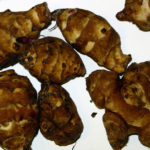What are prebiotics?
Prebiotics are indigestible ingredients for humans that, once in the colon, feed the resident good bacteria resulting in health benefits for the host.
If you have already read the entry about dietary fiber, you may have asked yourself… is it not the same?
Indeed, most prebiotics are dietary fibers but not all dietary fibers are prebiotics. The type of fiber where prebiotics are included is called “oligosaccharides”. Other not that well known prebiotics are some proteins.
So, what’s the difference between dietary fiber and prebiotics?
The oficial deffinition of prebiotics (look it up in the glossary) refers to “selectivity”. This word is the key to explain the difference between the two. It refers to the prerequisite a prebiotic must meet – that it needs to be selectively fermented in the colon only by a few beneficial bacteria. By contrast, dietary fibers not classified as prebiotics may be fermented by a large number of bacteria and their effects in host health not be well defined.
Recently, the prerequisite of selectivity has been challenged and a new definition proposed. You can find out more about this in the glossary.
There are currently many potential prebiotics but until they are not well defined and evidence of beneficial effects in humans confirmed, they cannot be classified as prebiotics. Well established prebiotics to date are fructooligosaccharides (FOS), galactooligosaccharides (GOS), oligofructose (OF), chicory fiber and inulin.
Where are prebiotics?
As prebiotics are mainly fibers, they are naturally found in some plant-based foods although usually at low levels. Some of the best food sources are:

- leeks
- asparagus
- chicory root
- Jerusalem artichokes
- garlic
- onions
- bananas (under-ripe)
- oats
Because the active oligosaccharides contained in these foods are relatively small, we would need to consume large quantities of them for a full prebiotic effect. The food industry has taken advantage of this and nowadays many foods are fortified with prebiotic compounds. In addition, prebiotics can also be found as supplements.
Prebiotics and the gut microbiota
Prebiotics travel along the gastrointestinal tract without being broken down – this is, they are resistant to degradation by hydrolisis or human digestive enzymes. They arrive intact to the colon, where some bacteria can ferment the prebiotic. This results in a selective stimulation of the growth and/or activity of beneficial indigenous microbes.
Currently, the beneficial bacteria being targeted by prebiotics are almost exclusively bifidobacteria and, to a lesser extent, lactobacilli. This is because the beneficial health effects of these componentes of the gut microbiota are well established in humans. As knowledge of the human microbiome advances, however, it is likely that many more microbes will be included in this category and the components that promote their growth or function labeled as prebiotics. Already some bacteria have been proposed, including eubacteria, propionibacteria, faecalibacteria or roseburia. The last two, for example, are producers of butyrate, a short chain fatty acid (SCFA) with proven health benefits in humans.
Health benefits of prebiotics
- Better digestive function – bowel regularity, protection from pathogens
- Support the immune system and lower inflammation
- Regulate appetite, energy balance and glucose metabolism
- Better mineral absorption, like calcium